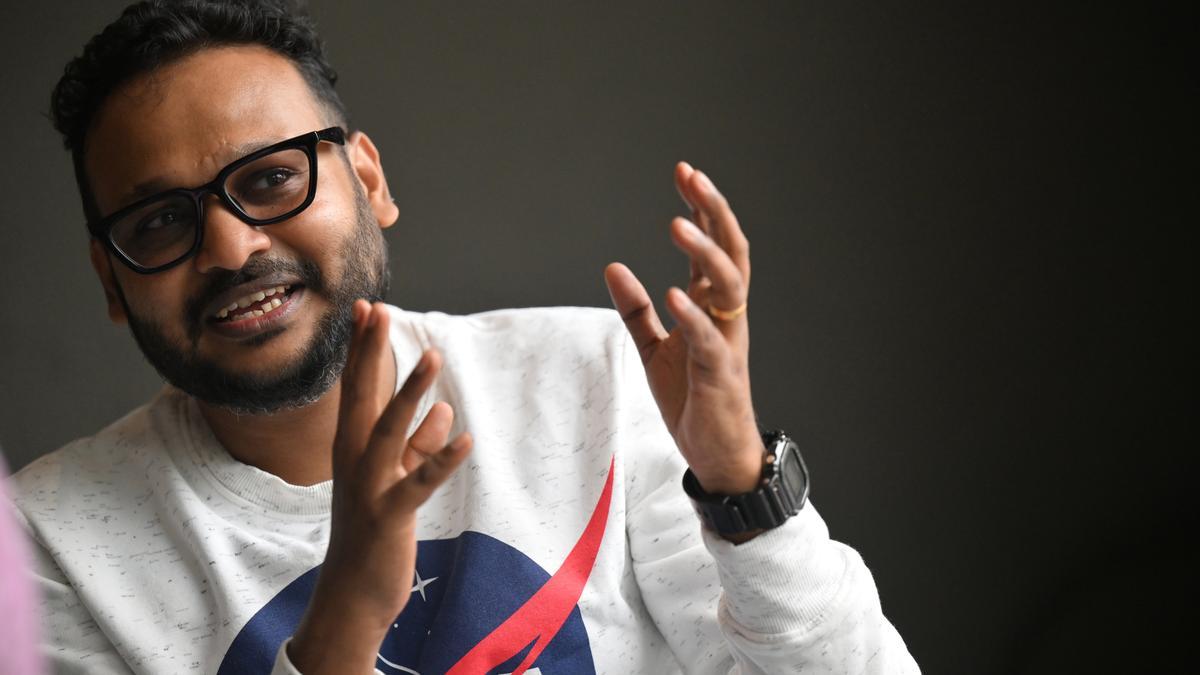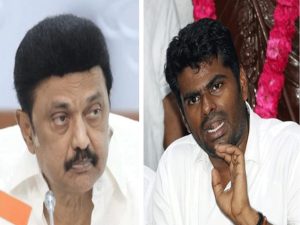
The white and blue NASA sweatshirt is a dead giveaway that Arun Chandu, the director of Gaganachari, is a space enthusiast. His palpable excitement over the film’s success at the box office is evident as he settles down for a chat. “Anyone who knows me knows I am a space buff and a Carl Sagan fan. I even have a Njaan Gandharvan poster with Carl Sagan’s face instead of Nitish Bharadwaj’s,” he chuckles.
Gaganachari, a sci-fi mockumentary set in a post-apocalyptic future, has been drawing crowds into theatres, becoming an unexpected hit among Malayalam films in 2024. The film, set in the 2040s, delves into a world threatened by aliens, climate change, and polarized political ideologies. Using the found footage technique, the storyline centers around three men—Ganesh Kumar, Aju Varghese, and Gokul Suresh—whose lives are upended when an alien (Aliyama, played by Anarkali Marakkar) arrives.
The humor in the movie successfully offsets the socio-political commentary. Arun skillfully navigates this balance while peppering the film with Malayalam pop culture references. A fan of mockumentaries like the horror-comedy series What We Do In The Shadows, Arun says, “After watching it, I wanted to create something political that would communicate hard-hitting truths through a mockumentary lens, but in a lighter tone.” The truths unfold in a manner that ensures there’s little room for offense.
Ganesh Kumar shines in the role of Victor Vasudevan, a middle-aged alien ‘hunter,’ with impeccable comic timing. Arun mentions, “Ganesh sir was part of my second directorial, Saajan Bakery, and I wrote Victor with him in mind. His south Kerala swag is top-notch, and he enjoyed being part of the film, perhaps because he understood its potential.”
Gokul Suresh, who collaborated with Arun on his debut film, Sayanna Varthakal (2018), shares a common interest in climate issues and UFO-related conspiracy theories with Arun. Their shared ideologies contributed to a strong working relationship. Arun’s journey in the film industry began with Vineeth Sreenivasan’s Thattathin Marayathu (2012), where he handled publicity design. This film marked the starting point of Arun’s association with Aju Varghese, another key actor in Gaganachari.
Contrary to the usual depiction of post-apocalyptic worlds as deserts (think Mad Max), Gaganachari presents a landscape devastated by water. Arun explains that heavy rainfall and the threat it poses to his home in Aranmula influenced this aesthetic choice. “Rain is more of a nightmare for me. My mother lives there with our pet dog, and I am constantly worried during heavy rains. So, it had to be water for me in a post-apocalyptic world.”
Filming Gaganachari was a daily challenge, entailing convincing both producers and actors of the project’s vision despite their unfamiliarity with the mockumentary genre.
. “They trusted the technician in me,” Arun states. The film’s success at various film festivals and its enthusiastic reception at the Kerala Pop Con in January 2024 boosted confidence among the team.
Written during the pandemic and filmed between 2020-21, the three-year wait for its theatrical release was ultimately beneficial. Arun remarks, “A three-year wait would typically render a film’s topics outdated. However, since Gaganachari is set in the future, its release timing remained relevant. If it had come out in 2025, it would still be current because we reference 2025 in the film.”
The film’s visual effects, created on a modest budget, were enhanced by evolving AI and CGI technology. Arun and his team adopted a minimalist approach to visual effects, drawing inspiration from the sci-fi action film District 9. During its festival circuit, Gaganachari competed in around 60 festivals and won awards at approximately 25, notably receiving a standing ovation at the Pramana Asian Film Festival in Calabria, Italy. Arun notes, “I learned that cinema transcends language. Even if audiences didn’t get the pop culture references, they understood the themes of geo-politics and climate change.”
The initial concept for Gaganachari was darker and gorier, akin to A Quiet Place, but advice from Aju Varghese led Arun to infuse the story with humor. “Ajuettan suggested, ‘Why scare people more during an already grim pandemic? Lighten it up.’ Subsequently, I reworked it with input from friends like US-based film writer Rahul Menon,” Arun explains.
The audience demographics surprising Arun the most, with a broad age range turning up for the film. “Our promotional material targeted 18-25-year-olds, but families are watching it together. It’s appealing to all age groups,” he says. He acknowledges that the film’s experimental nature and the gritty, found footage technique might not have worked with a different subject.
Arun credits the Malayali audience for the film’s success, echoing Fahadh Faasil’s sentiment that diverse content finds acceptance in Kerala. He also attributes this openness to the varied content people consumed on OTT platforms during the pandemic.
Not done with the Gaganachari universe, Arun hints at his next project, Maniyan Chittappan, starring Suresh Gopi, which was referenced in Gaganachari. “Gaganachari has so much potential; it can be developed like the Marvel universe,” he concludes.
Gaganachari is currently showing in theatres, captivating audiences of all ages.












